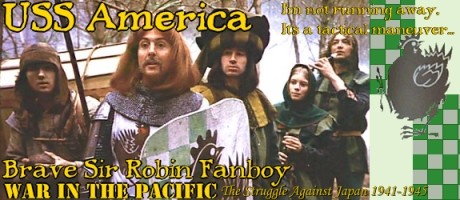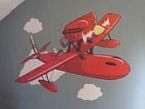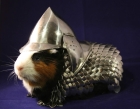JeffroK
Posts: 6391
Joined: 1/26/2005
Status: offline

|
quote:
ORIGINAL: VSWG
quote:
ORIGINAL: wdolson
If I remember right, the B-17F had uprated engines, but also had more armor and was overall heavier, so it had poorer range.
It just seems that only the downsides of the -F made it into the stats, and none of the improvements - whatever they are: my (amateurish) web search for this model revealed only better engines and more powerful propeller blades as improvements. Is there a good website with info about different variants (for B-17s, or ww2 planes in general)?
Thanks for all replies.
Again from the great Joe Baugher
http://www.joebaugher.com/usaf_bombers/b17_11.html
Boeing B-17F Fortress
The B-17F (Model 299P) immediately followed the E-model off the production line. Early operational experiences with the B-17D in the Pacific theatre had led to a further series of design improvements that were worked out in early 1942 and introduced on the B-17F.
The B-17F was externally almost identical to the earlier B-17E. Externally, the F could be distinguished from the E only by the use of a single piece plastic blown transparent nose. Apart from the optically-flat bomb aiming panel, the nose transparency was frameless. However, there were over 400 internal changes, designed to make the bomber a more effective fighting machine. A new ball turret was fitted, external bomb racks were provided, wider paddle-bladed propellers were fitted, an improved oxygen system, carburetor air intake dust filters, dual brake system, more photographic equipment, an electronic link between the autopilot, and additional ball-and-socket machine gun mounts in the nose. The engines were the newer Wright R-1820-97 Cyclones, which could offer a war emergency power of 1380 hp for brief intervals. Revisions to the engine cowlings were required to make it possible to feather the wider propeller blades. A stronger undercarriage was installed which allowed the maximum weight to increase to 65,000 pounds, and later to 72,000 pounds.
The first B-17F (41-24340) flew on May 30, 1942. Because of the great number of relatively small changes constantly being introduced on the B-17F production line, the production block designation scheme had to be introduced to make it possible for field maintenance units to keep track of the multitudinous numbers of different varieties of B-17Fs that were in service. The first 50 were B-17F-1-BO, the second 50 were -5, and the third 50 were -10, but the numbers in each block varied from this point on. A total of 2300 B-17Fs were built by Boeing, the last production block being -130-BO.
After receiving a B-17E pattern aircraft and all necessary blueprints from Boeing, the Vega division of Lockheed began production of the B-17F in its new A-1 plant at the edge of the Lockheed Air Terminal in Burbank, California. The first B-17F-1-VE (42-5705) flew on May 4, 1942. A total of 500 B-17Fs were built by Lockheed-Vega (with the production block numbers reaching -50) before production switched to the G-model. The Lockheed-built B-17Fs were essentially identical to the Boeing-built version, and the planes could only be distinguished from each other by an examination of their serial numbers.
The Douglas plant at Long Beach, California also began production of the B-17F. Douglas manufactured a total of 605 B-17Fs (B-17F-1-DL thru -85-DL). The Douglas-built B-17Fs were externally identical to the Boeing- and Lockheed-built models, and could only be distinguished by an examination of their serial numbers.
Only the first three Douglas-built B-17Fs and the first five Vega-built B-17Fs were block number 1. The details of similar B-17F block numbers as built by the three companies did not correspond, so it was necessary to include the manufacturer's code (BO for Boeing, DL for Douglas, VE for Vega) for complete determination of details for service publications.
The B-17F went into action with the 8th Air Force in Europe, and was used for the first American bombing raid against the German homeland on January 27, 1943 in a raid on Wilhelmshaven. Combat by the B-17F over Europe soon revealed that it was vulnerable to attack from the front by enemy fighters. It turned out that most of the factory-installed pieces of heavy armor plate and flak curtains were not well-positioned to protect the crew against frontal attacks. When hit from the front by machine gun or cannon fire, the crew of the B-17 was relatively unprotected. Hasty modifications were made in the field in an attempt to beef up the armor protection, but were not entirely successful. Another option that was explored was an increase in the number of forward-firing machine guns. In order to beef up the forward defensive firepower, various installations were made in the field to increase the armament in the nose. Additional flexible machine gun installations were fitted in the nose, firing from extra sockets cut into the nose cone or from windows cut into the side of the nose. The famous "Memphis Belle", a B-17F-10-BO (41-24485) of the 324th Bombardment Squadron, 91st Bombardment Group had no less than four guns sticking out of its nose, two in sockets cut into the Plexiglas nose and two firing from windows cut into the left and right sides of the nose.
Later models of the B-17F could be fitted with extra cells (called "Tokyo tanks") to the fuel tanks in the wings.
The B-17Fs built by the three companies differed slightly in internal details, particularly in armament. The most commonly used initial arrangement was a 0.30-inch gun in the nose with 500 rounds, two 0.50-inch with 300 rpg in the waist, two 0.50-inch with 400 rpg in the wait, two 0.50-inch guns with 400 rpg in the dorsal turret, two 0.50-inch guns with 500 rpg in the ball, and two 0.50-inch guns with 565 rpg in the tail.
The maximum bombload of the first B-17Fs was 9600 pounds, but the range over which such loads could be carried was quite short. On typical missions the load was 4000-5000 pounds over operating ranges of 1400 miles. Beyond these distances, the bombload fell off quite rapidly
Many modifications were introduced at modification centers before the planes reached the field. These changes were largely dictated by experience in Europe, and were mostly concerned with armor, armament, and fuel capacity.
Beginning with the B-17F-30-BO, another gun was added at the opening on the top of the radio compartment, firing upward from the transparent hatch just above the wing trailing edge.
Beginning with B-17F-30-BO, B-17F-20-DL, and B-17F-20-VE, external bomb racks were fitted under the inner wings for the carriage of two 4000-pounds bombs. This brought the maximum short-range bombload to 17,600 pounds. Under certain conditions, eight 1600-pound bombs could be carried internally and two 4000-pound bombs externally, raising the total load to 20,800 pounds. However, with such a load the effective range was quite small and all maneuvers were severely restricted. Consequently, external bombs were only rarely carried by the B-17F. Although all subsequent models had lugs and controls for their attachment, the underwing racks were not installed at the factory.
The fuel capacity of the B-17F was increased from 2550 to 3630 US gallons in later modifications .
A total of 3405 B-17Fs were built--2300 by Boeing, 605 by Douglas, and 500 by Lockheed-Vega.
One B-17F (Serial number 42-3521) was transferred to the US Navy. It was given the Navy serial number of 34106, but was operated under its Army designation. It was later modified to B-17G standard and redesignated PB-1. It was later stripped of all armament and used as a flying aeronautical laboratory.
B-17F 41-24613 was turned over to the National Advisory Committee for Aeronautics (NACA) for extensive performance testing under the designation XB-17F. Despite its designation, it was not a prototype.
Only three B-17Fs remain in existence today.
* B-17F-10-BO 41-24485
The famous Memphis Belle, a B-17F-10-BO (41-24485) of the 324th Bombardment Squadron, 91st Bombardment Group was the first American bomber to complete 25 missions over Europe and survive. This 25th mission was flown on May 17, 1943. Following this mission, the plane returned to the USA to take part in a war bond tour. Upon completion of the tour, the Memphis Belle was turned over to a training group at McDill Field in Florida. In 1945, it was redesignated TB-17F. In August of 1945, it was consigned to the Reconstruction Finance Corporation for disposal. It was about to be scrapped when a citizen of Memphis happened to note that it was the famous Memphis Belle and should be saved. The plane was rescued from the scrap heap and was flown to Memphis, Tennessee where it was put on display outdoors on a pedestal. Over the succeeding years, Memphis Belle began to show signs of wear and tear as the inevitable effects of weather and vandals took their toll. Public outcry at the sorry state of Memphis Belle led to a major restoration effort. Finally, in 1987, a fully-restored Memphis Belle, now sporting a more-accurate paint scheme, was put on permanent display underneath a protective dome. In October of 2005, the USAF reclaimed ownership of the Memphis Belle and it was transferred by truck to Wright Patterson AFB in Ohio, where it is now undergoing a thorough restoration.
* B-17F-50-DL 42-3374
B-17F-50-DL serial number 42-3374 is currently in storage at Offutt AFB, Nebraska awaiting restoration and display. It was a Douglas-built machine which never went overseas. Following the war, it was transferred to the Metro-Goldwyn-Mayer (MGM) film studio to be used in making the movie *Footprints in the Sky". In the event, this film never got made and 42-3374 sat in storage at MGM until the 1960s. At that time, it was transferred to Ed Maloney's "Planes of Fame" air museum at Chino Airport in California. Ed Maloney traded the plane to the Beale AFB museum in 1981. In 1989, 42-3374 was trucked to Offut AFB to be displayed as a gate guardian. It is currently in storage awaiting further plans.
* B-17F-70-BO 42-29782
There is only one flyable B-17F currently in existence. It is B-17F-70-B0 serial number 42-29782, which spent the war stateside with training units. It was surplused in November 1945. In 1946, it was given to Stuttgart, Arkansas for display. However, Stuttgart city government tired of the display and turned the plane over to civilian operators. The civil registration N17W was assigned. It operated for a number of years as a pesticide sprayer and as an aerial tanker. It appeared in the films *1000 Plane Raid*, *Tora, Tora, Tora*, and the 1989 remake of "The Memphis Belle". In *The Memphis Belle*, it appears as *Kathleen*, and was the only genuine B-17F used in the making of the film.
If you want to find out more information about the fates of some individual B-17Fs, check out my serial number page.
_____________________________
Interdum feror cupidine partium magnarum Europae vincendarum
|
 Printable Version
Printable Version





















 New Messages
New Messages No New Messages
No New Messages Hot Topic w/ New Messages
Hot Topic w/ New Messages Hot Topic w/o New Messages
Hot Topic w/o New Messages Locked w/ New Messages
Locked w/ New Messages Locked w/o New Messages
Locked w/o New Messages Post New Thread
Post New Thread